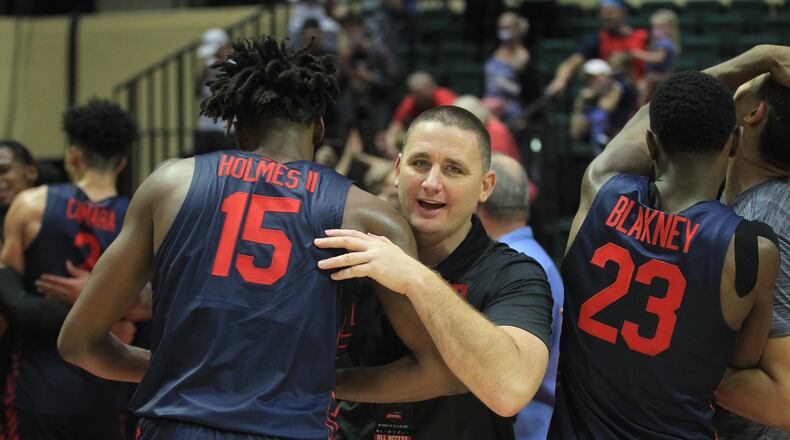“Chasing the money isn’t worth it,” Holmes said then. “I’d rather have the true love. Loyalty really does mean something to me.”
Holmes isn’t the only Flyer who has had that experience. A source close to another current UD player said that player also had been approached by other programs.
Dayton Athletic Director Neil Sullivan, who talked to the Dayton Daily News on a wide variety of topics related to the men’s basketball team on Thursday, had strong comments on the tampering problem in college sports.
“It’s outrageous and out of control,” Sullivan said. “That’s the best way I can say it. I guess I’ll be really blunt about it. There are very few NIL rules and regulations, but to the NCAA’s credit — if there is much credit to give — there are a couple clear rules that are written in what I call fifth-grade plain English. One of those is that recruiting conversations between boosters, collectives and prospects are just not allowed. Coaches can’t coordinate to have a kid in the portal talk to a collective. It’s just flat not allowed.”
But everyone knows the tampering happens, Sullivan said. Dusty May, who coached Florida Atlantic to the Final Four this year, spoke about the issue before the Elite Eight.
“You’re always concerned because they’re getting recruited now,” May said. “They’ve been recruited through this tournament. It’s part of it. Our job as coaches is to do the best job we can every single minute of every single day to provide the environment that they think this is the best thing for them long-term. Not today, not in a week, not in a month but long-term.”
Sullivan said “the adults involved in (tampering) should be embarrassed. But it is what it is at this point. At Dayton, our coaches do the recruiting. It’s that simple.”
There is a collective supporting UD athletes, the Dayton 6th, which launched in October. Sullivan said potential recruits hear about Dayton 6th and learn how current athletes have benefitted from it and other NIL deals — Holmes, for example, endorses Lee’s Famous Recipe Chicken and the White-Allen Auto Group — but don’t sign deals or get promised any deals if they commit to Dayton.
“(Other schools) are negotiating certain things on the front end,” Sullivan said. “There’s a lot of nuance to NIL, but it’s a real challenge outside of the proverbial smoking gun. It’s a lot of winks and nods and backdoor reach-outs and coaches saying, ‘Well, I didn’t tell that booster to reach out.’ Coaches are Type-A personalities. I can assure you that other people are not doing their recruiting for them without their input.”
The transfer portal, even outside of the tampering issue, has changed college sports in many ways. Fans of the Flyers know that as well as anyone.
The idea of a freshman class staying together for four seasons and graduating together — as the 2013 class of Scoochie Smith, Kendall Pollard and Kyle Davis did — seems far fetched these days.
Only one player remains from Dayton’s four-man 2020 freshman class who will be seniors in the 2023-24 season: Koby Brea. R.J. Blakney and Mustapha Amzil entered the transfer portal this spring. Luke Frazier left in 2021 after his freshman season.
Six Dayton players have left the program since December, five of them entering the portal. Ten UD players have entered the portal since 2021 when the NCAA did away with the rule requiring players to sit out one season after transferring.
Sullivan was asked what fans should think about state of their favorite team with the portal changing the roster in such a major way this year.
“The transfer portal works both ways and always has,” Sullivan said. “Dayton has been a net beneficiary of transfers over my time Dayton, so I don’t think transfers are necessarily new or bad, but the motivation and the timing of transfers is really radically unstable and unpredictable. Transferring was traditionally, on average, about culture. Maybe a young player was playing behind a great upperclassman. They needed a different opportunity. There was a coaching change. Or maybe a kid just made a decision out of high school, and they wanted a do-over. Very legitimate reasons.”
Dayton has already added two players to its roster from the portal this spring: guards Enoch Cheeks, of Robert Morris, and Javon Bennett, of Merrimack. Two of the team’s top-four scorers last season, Toumani Camara and Kobe Elvis, joined the program as transfers in the 2021-22 season.
Sullivan is right when he says Dayton has gained more talent from the portal than it has lost. In a seven-year stretch from 2011-17, a transfer led Dayton in scoring every season: Kevin Dillard (Southern Illinois); Jordan Sibert (Ohio State); Charles Cooke (James Madison); and Josh Cunningham (Bradley).
Still Dayton has never seen the roster turnover that has hit it this year in a year in which there wasn’t a coaching change.
“The environment is very transactional — not all transfers — but it increasingly feels like a commodity that is bought and sold and traded on a board of exchange,” Sullivan said. “Leading scorers on teams, All-Americans. I think I read four McDonald’s All-Americans from last year are already in the portal. So I think the big shift is nothing’s sacred.”
Sullivan mentioned players transferring from one program to another in the same league, which has happened with three players in the Atlantic 10 Conference this season.
“There’s no transfer motivation that’s off limits,” Sullivan said. “You’ve got backdoor NIL and anything else you can think of it. It’s hard to make sense of it all. But at the end of the day, our only option is to look at it as Dayton has been a net beneficiary of transfers into our program. We have to look at disruption as an opportunity. Whining about it is not going to get us anywhere. It’s the environment that that we’re in.”
About the Author

